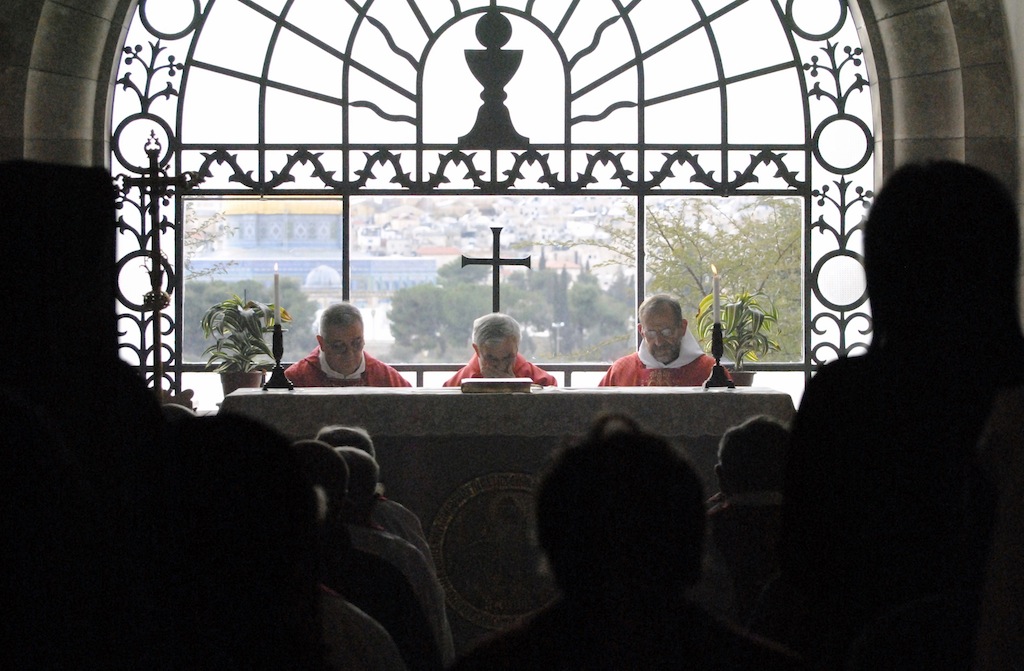
On the afternoon of Wednesday 7th March there was the traditional Lenten peregrination to the Shrine of Dominus Flevit, which means “the Lord wept”, on the slopes of the Mount of Olives. This small church, with its very original shape which recalls a drop and so moving with the splendid panorama of the Holy City that can be enjoyed from the window behind the great altar, was built by the architect Antonio Barluzzi in 1955 on the remains of a Byzantine church, with some of its 7th century mosaics still preserved on the floor. Tradition associates this place with the episode described in the Gospel according to St. Luke when Jesus wept for Jerusalem (Luke19,41-44), "it did not recognize the time of its visitation" and "it did not know what made for peace."
For a long time, the Franciscans of the Custody of the Holy Land have cultivated peregrinations, as a special act of devotion which consists of coming together and praying in the places of the passion and death of Jesus, as narrated in the Gospels and consolidated by Christian tradition.
According to the Lenten liturgy at the Church of Dominus, there is the celebration of a solemn and sung Holy Mass, preceded by the prayer of Vespers, and it inherits rituals and devotional practices that are centuries old.
The Holy Mass was presided by Brother Artemio Vitores, Custodial Vicar, with the very large Franciscan community of the Custody gathered around him. There were also many religious belonging to the different congregations of the Holy Land who took part in the moving celebration, together with some local Christians and a small number of pilgrims.
The Lenten pilgrimage of the Franciscans, which will continue every week, stopping at a different shrine, starts from the place where the Lord, seeing the extraordinary beauty of His beloved city, wept for its fate of suffering and division. This pilgrimage is therefore above all an interior path of approaching the mystery of salvation, the possibility of being immersed, with Jesus, in all the moments and in all the expressions of His suffering, until the climax of His death on the cross, from which he will rise, victorious and resurrected, on Easter morning.
By Caterina Foppa Pedretti
Photos by Brother Adelmo Vásquez Díaz
For a long time, the Franciscans of the Custody of the Holy Land have cultivated peregrinations, as a special act of devotion which consists of coming together and praying in the places of the passion and death of Jesus, as narrated in the Gospels and consolidated by Christian tradition.
According to the Lenten liturgy at the Church of Dominus, there is the celebration of a solemn and sung Holy Mass, preceded by the prayer of Vespers, and it inherits rituals and devotional practices that are centuries old.
The Holy Mass was presided by Brother Artemio Vitores, Custodial Vicar, with the very large Franciscan community of the Custody gathered around him. There were also many religious belonging to the different congregations of the Holy Land who took part in the moving celebration, together with some local Christians and a small number of pilgrims.
The Lenten pilgrimage of the Franciscans, which will continue every week, stopping at a different shrine, starts from the place where the Lord, seeing the extraordinary beauty of His beloved city, wept for its fate of suffering and division. This pilgrimage is therefore above all an interior path of approaching the mystery of salvation, the possibility of being immersed, with Jesus, in all the moments and in all the expressions of His suffering, until the climax of His death on the cross, from which he will rise, victorious and resurrected, on Easter morning.
By Caterina Foppa Pedretti
Photos by Brother Adelmo Vásquez Díaz

